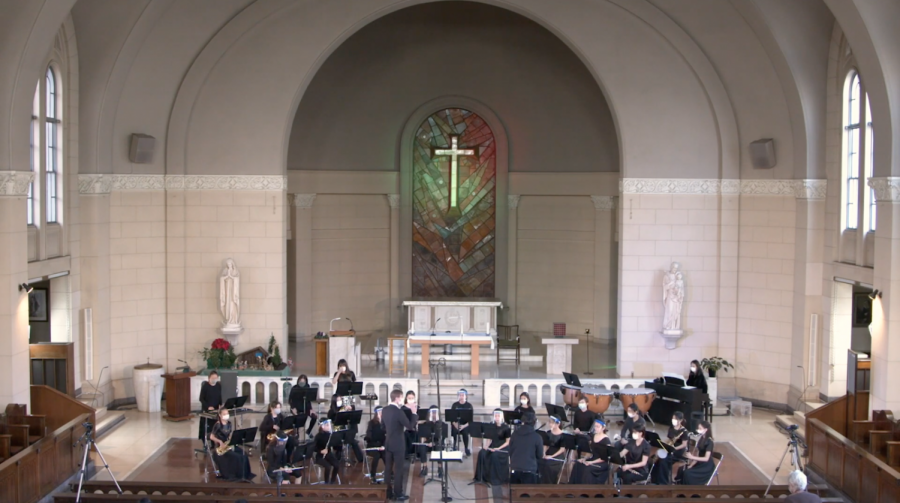The International School of the Sacred Heart Tokyo Youtube screenshot
Limiting the orchestra: dividing to be smaller and concentrated
The most rewarding aspect of participating in Orchestra is practicing as a member of a large yet harmonious wave of sound, to perform your best and bask in the applause of a live audience. Amid COVID-19 precautions, this experience seemed a distant fantasy. With wind and brass instruments relying on breath and spit to make sound, the continuation of regular orchestra practices would have increased the spread of the air-born virus.
To combat this, the orchestra director, Mr. Nicholson, has changed the structure of practices entirely. The once collective orchestra is now split in two: a strings-only orchestra and the winds-brass band. They coordinate separately — strings practicing on Thursday after school and the band on Monday lunchtime — and seats are placed to ensure social distancing. The ends of brass and wind instruments have a cloth that acts as a barrier, and make-shift masks were created for wind-brass orchestra, with a hole through the mask to put instruments in.
With these strict restrictions in place, the orchestra was able to continue in-person practices in the first semester. The separation into two separate groups brought both benefits and losses. On one hand, smaller groups gave each member a small spotlight to showcase their skills. For example, the new chamber band repertoire gave solos to the clarinets and trumpets where full orchestra music could not. On the other hand, the complete-ness created with the range of instruments in a full orchestra was missing — the spice created through the molding of strings, winds, brass, and percussion was simply not there. The choice to separate undeniably impacted the genre of music made, and each orchestra member took this chance to further fine-tune their quality of music. Yet, in all honesty, practices did not feel isolated or drastically different at all. Weekly practices were still conducted in-person, and the loud and harmonious music made from dozens of musicians still played in the Duchesne room.
These modified rehearsals led to Sacred Heart’s annual Christmas concert, which was not performed to a live audience, but rather pre-recorded and uploaded to YouTube. Even then, the experience of setting up, tuning, and performing in the Chapel was identical to previous years, only with the added flexibility of recording several videos and choosing the best to post online. Just the simple act of hearing the orchestra’s sound resonate within the Chapel walls was gratifying, especially compared to how the members could only practice and record by themselves in the second semester of the 2019-2020 school year. By the time the perfect recording of music from the Polar Express and “We Wish You a Merry Christmas” was taken, the Sacred Heart orchestra members were leaving the Chapel doors thrumming with Christmas spirit and a small dose of adrenaline pumping from performing together.
For more experienced members, participating in the Kanto Plain Honor Band and Honor Orchestra is one of the year’s most appealing opportunities. There was no significant adaptation in Honor Band and Orchestra auditions this year as the auditions are always held online. This December, 2020, Sacred Heart musicians recorded their audition pieces to be judged — and they were successful. Sixteen students will be representing Sacred Heart in the 2021 Honor Band/Orchestra in the (likely) virtual concert in March.
Unfortunately, Tokyo saw a sudden spike to 1000+ cases per day in early January 2021. To combat this, all Sacred Heart after school activities were canceled and the orchestra was no exception. It goes without saying that practicing alone on a piece made for an entire orchestra feels empty and lacking; without a doubt, the orchestra members are looking forward to the day when they are able to play in-person again.
